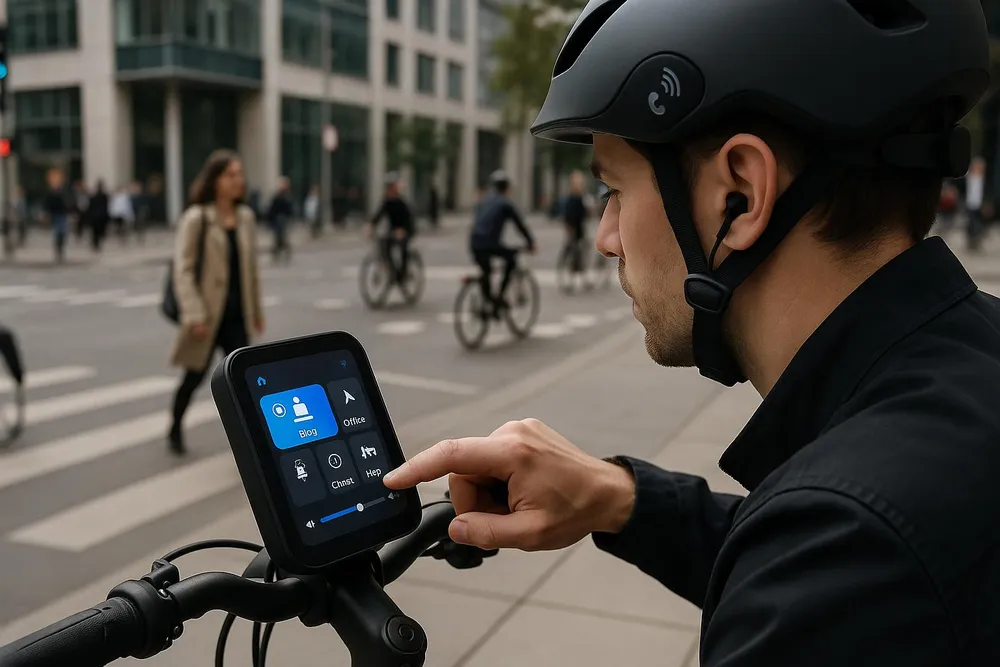The cycling safety landscape has undergone a revolutionary transformation in 2025, where advanced visibility technologies, intelligent radar systems, and sophisticated communication devices are fundamentally changing how cyclists protect themselves and interact with traffic environments. What was once limited to basic reflectors and simple lights has evolved into a comprehensive ecosystem of interconnected safety technologies that provide unprecedented protection and awareness for cyclists of all levels.
According to industry experts, recent technological innovations are helping more people feel confident on the bike and excited to ride, with safety technologies creating a more connected and confident riding experience wherever the road or trail leads [1]. This technological revolution represents not just incremental improvements in existing safety equipment, but entirely new categories of protection that were unimaginable just a few years ago.
Daytime Running Light Revolution: Visibility Beyond Traditional Lighting
The most significant breakthrough in cycling visibility technology has been the development of daytime running lights that use specific flash patterns, focus, and range to help riders stand out to drivers more than a mile away, even in broad daylight [2]. These advanced lighting systems represent a fundamental shift from traditional cycling lights that were primarily designed for low-light conditions to sophisticated visibility systems that provide protection throughout the entire day.
Modern daytime running lights utilize advanced LED technology combined with precisely engineered optical systems that create distinctive flash patterns specifically designed to catch the attention of motorists. The science behind these systems involves understanding human visual perception and attention patterns, creating light signatures that are immediately recognizable as cyclist presence indicators even in challenging lighting conditions.
The integration of ambient light sensors allows these systems to automatically adjust their intensity and flash patterns based on environmental conditions, ensuring optimal visibility without creating glare or distraction for other road users. Advanced models incorporate GPS data to modify their behavior based on location-specific traffic patterns and road conditions, providing enhanced protection in high-risk areas.
Battery technology improvements have made it possible for these high-intensity daytime running lights to operate for extended periods without compromising performance. Smart charging systems and power management algorithms ensure that cyclists never find themselves without protection due to battery depletion, with some systems providing weeks of operation on a single charge.
The effectiveness of daytime running lights has been validated through extensive research and real-world testing, with studies showing significant improvements in driver awareness and reaction times when cyclists are equipped with these advanced visibility systems. The technology has become so effective that many cycling organizations and safety advocates now consider daytime running lights essential equipment for all cycling activities.
Rear-Facing Radar Technology: Revolutionizing Traffic Awareness
Perhaps the most transformative safety innovation in cycling has been the development and refinement of rear-facing radar technology that helps riders stay aware of approaching traffic while simultaneously making them more visible to others on the road [3]. These sophisticated systems represent a quantum leap in cycling safety technology, providing cyclists with information that was previously impossible to obtain without constantly looking over their shoulder.
Modern cycling radar systems utilize advanced signal processing and machine learning algorithms to distinguish between different types of approaching vehicles, providing cyclists with detailed information about the speed, distance, and trajectory of traffic behind them. The systems can differentiate between cars, trucks, motorcycles, and other cyclists, providing appropriate alerts and information for each type of approaching traffic.
The integration of radar technology with cycling computers and smartphone applications has created comprehensive traffic awareness systems that provide both visual and audible alerts about approaching vehicles. These systems can be customized to individual preferences and riding conditions, providing more aggressive alerts in high-traffic areas while remaining unobtrusive during recreational rides in low-traffic environments.
Advanced radar systems now incorporate predictive analytics that can anticipate potentially dangerous situations based on vehicle approach patterns and road conditions. These systems can provide early warnings about vehicles that are approaching at unsafe speeds or following dangerous trajectories, giving cyclists additional time to take evasive action or position themselves more safely on the road.
The reliability and accuracy of modern cycling radar systems have improved dramatically, with false positive rates reduced to minimal levels through advanced filtering algorithms and environmental adaptation systems. These improvements have made radar technology practical for everyday cycling use, rather than just specialized applications.

Digital Communication and Audio Safety Innovation
The development of digital bells with Bluetooth speakers and advanced sound engineering has revolutionized how cyclists communicate their presence in congested areas and complex traffic environments [4]. These sophisticated audio systems represent a complete reimagining of traditional bicycle bells and horns, incorporating modern communication technology to ensure that cyclists can be heard as well as seen.
Advanced digital bell systems utilize directional audio technology that can focus sound in specific directions, allowing cyclists to alert particular road users without creating unnecessary noise pollution. The systems can produce a variety of tones and patterns that are specifically designed to be attention-getting without being aggressive or startling.
Bluetooth integration allows these systems to connect with smartphones and cycling computers, enabling voice announcements, navigation prompts, and emergency communications through the same audio system used for traffic alerts. This integration creates a comprehensive communication platform that enhances both safety and convenience for cyclists.
Smart audio systems can automatically adjust their volume and tone based on ambient noise levels and traffic conditions, ensuring that alerts are always audible without being unnecessarily loud in quiet environments. Advanced models incorporate noise cancellation technology that helps ensure clear communication even in challenging acoustic environments.
The integration of emergency communication features allows cyclists to send automated distress signals or location information through their audio systems, providing an additional layer of safety protection that can be activated even when cyclists are unable to use their hands or access their phones directly.
Integrated Safety Ecosystem: Comprehensive Protection Systems
The true revolution in cycling safety technology lies not in individual devices but in the integration of multiple safety systems into comprehensive protection ecosystems that provide layered defense against various types of risks and hazards. These integrated systems represent a holistic approach to cycling safety that addresses visibility, communication, navigation, and emergency response in coordinated fashion.
Modern integrated safety systems combine radar detection, advanced lighting, communication devices, and smartphone connectivity into seamless platforms that provide comprehensive situational awareness and protection. These systems can share data between components to provide more accurate and relevant safety information, creating synergistic effects that exceed the capabilities of individual devices.
Artificial intelligence integration allows these systems to learn from individual riding patterns and environmental conditions to provide increasingly personalized and effective safety protection. The systems can adapt their behavior based on factors such as time of day, traffic conditions, weather, and individual risk tolerance to provide optimal protection without unnecessary interference.
Cloud connectivity enables these systems to share anonymized safety data with other cyclists and traffic management systems, creating collaborative safety networks that benefit entire cycling communities. This data sharing can help identify dangerous road conditions, traffic patterns, and accident hotspots that can inform both individual route planning and infrastructure improvement efforts.
The integration of health monitoring capabilities allows safety systems to detect potential medical emergencies or fatigue-related safety risks, providing alerts and assistance that go beyond traditional traffic-related safety concerns. These systems can monitor heart rate, activity levels, and other physiological indicators to identify situations where cyclists may be at increased risk.
Smart Infrastructure Integration and Connected Safety
The evolution of cycling safety technology has been accelerated by the development of smart infrastructure systems that can communicate directly with cyclist safety equipment to provide enhanced protection and information. These vehicle-to-infrastructure (V2I) and infrastructure-to-cyclist (I2C) communication systems represent the cutting edge of connected transportation safety.
Smart traffic signals can now detect approaching cyclists and adjust timing to provide safer crossing opportunities, while also communicating directly with cyclist safety systems to provide advance warning about signal changes and traffic conditions. This integration creates a more responsive and cyclist-aware traffic management environment.
Connected road infrastructure can provide real-time information about road conditions, construction zones, and hazards directly to cyclist safety systems, enabling proactive route adjustments and safety preparations. These systems can alert cyclists to dangerous conditions well in advance, providing time for alternative route planning or additional safety precautions.
The integration of weather monitoring systems with cycling safety technology provides real-time alerts about changing conditions that could affect visibility or road safety. These systems can automatically adjust safety device settings based on weather conditions and provide recommendations for additional safety measures when conditions deteriorate.
Emergency response integration allows cycling safety systems to automatically contact emergency services and provide precise location information in the event of accidents or medical emergencies. These systems can provide first responders with detailed information about the cyclist’s condition and circumstances, potentially improving response times and treatment outcomes.

Social Connectivity and Community Safety Networks
Technology is linking cyclists to one another in unprecedented ways, allowing for near-constant communication among riders who are not actually riding together, creating virtual safety networks that enhance protection through community awareness and support [5]. These social connectivity features represent a new paradigm in cycling safety that leverages the collective knowledge and vigilance of cycling communities.
Advanced cycling applications now provide real-time sharing of safety information, including road hazards, traffic conditions, and dangerous driver behavior, creating crowdsourced safety intelligence networks that benefit all community members. These systems allow cyclists to warn others about immediate dangers and provide updates about changing conditions along popular routes.
Group ride coordination technology has evolved to provide sophisticated safety management for organized cycling activities, including real-time location tracking, communication systems, and emergency response coordination. These systems help ride leaders maintain awareness of all participants and provide rapid response capabilities in case of accidents or mechanical problems.
The gamification of safety behavior has created engaging systems that encourage cyclists to adopt and maintain safe riding practices through achievement systems, safety challenges, and community recognition programs. These systems help reinforce positive safety behaviors while creating social connections around shared safety values.
Virtual coaching and safety education systems provide personalized training and feedback about safe riding techniques, helping cyclists develop better safety habits and situational awareness skills. These systems can analyze riding patterns and provide specific recommendations for improvement based on individual behavior and local conditions.
Future Innovations and Emerging Safety Technologies
The cycling safety technology landscape continues to evolve rapidly, with emerging innovations promising even more sophisticated and effective protection systems. Artificial intelligence and machine learning technologies are being developed to provide predictive safety analysis that can anticipate dangerous situations before they develop into actual hazards.
Augmented reality integration is being explored to provide heads-up safety information that can alert cyclists to hazards and traffic conditions without requiring them to look away from the road. These systems could provide visual overlays that highlight dangerous vehicles, road hazards, and optimal positioning information directly in the cyclist’s field of view.
Advanced sensor fusion technology is being developed to combine multiple types of detection systems into comprehensive environmental awareness platforms that can identify and track multiple types of hazards simultaneously. These systems could provide unprecedented situational awareness by integrating radar, lidar, camera, and audio detection capabilities.
Biometric monitoring integration promises to provide real-time assessment of cyclist alertness and physical condition, potentially identifying fatigue or medical conditions that could compromise safety before they become dangerous. These systems could provide early warnings and recommendations for rest or medical attention when needed.
Economic Impact and Industry Transformation
The cycling safety technology revolution has created significant economic opportunities while driving down the costs associated with cycling accidents and injuries. Insurance companies are beginning to offer discounts for cyclists who use advanced safety equipment, recognizing the demonstrated effectiveness of these technologies in preventing accidents and reducing injury severity.
The development of safety technology has spurred innovation across the cycling industry, with manufacturers investing heavily in research and development to create more effective and user-friendly safety systems. This investment has accelerated the pace of innovation and driven down costs, making advanced safety technology accessible to a broader range of cyclists.
Government agencies and transportation departments are increasingly incorporating cycling safety technology considerations into infrastructure planning and traffic management systems, recognizing the potential for technology to improve safety outcomes while reducing the costs associated with cycling accidents and injuries.
The growth of the cycling safety technology market has created new business opportunities and employment in technology development, manufacturing, and support services, contributing to economic growth while improving public safety outcomes.
Conclusion
The cycling safety and visibility technology revolution of 2025 represents a fundamental transformation in how we approach cyclist protection and traffic interaction. These advanced systems have moved beyond simple visibility aids to create comprehensive safety ecosystems that provide unprecedented protection and awareness for cyclists in all environments and conditions.
The integration of radar technology, advanced lighting systems, intelligent communication devices, and connected infrastructure has created a new paradigm in cycling safety that addresses multiple types of risks through coordinated, intelligent systems. As these technologies continue to evolve and become more accessible, they promise to make cycling safer and more appealing to broader populations while preserving the freedom and enjoyment that define the cycling experience.
The future of cycling safety lies in the continued integration of these technologies with smart infrastructure and connected transportation systems, creating environments where cyclists are not just protected by their own equipment but supported by intelligent systems that actively work to prevent accidents and enhance safety for all road users.
For more insights on cycling and technology, explore our comprehensive guides on Smart Cycling Technology Revolution: How Connected Gear and AI Integration Are Transforming the Cycling Experience in 2025, GPS Safety Technology Revolution: How Smart Tracking Systems Are Transforming Cycling Safety in 2025, Urban Cycling Infrastructure Revolution: How Smart Cities Are Transforming the Cycling Experience in 2025, and Cycling Apps Revolution: How Smart Technology and AI Are Transforming Every Aspect of Your Ride in 2025.
Explore additional resources on Trek Bicycle Safety Technology, Garmin Cycling Safety Products, and Specialized Safety Technology.




